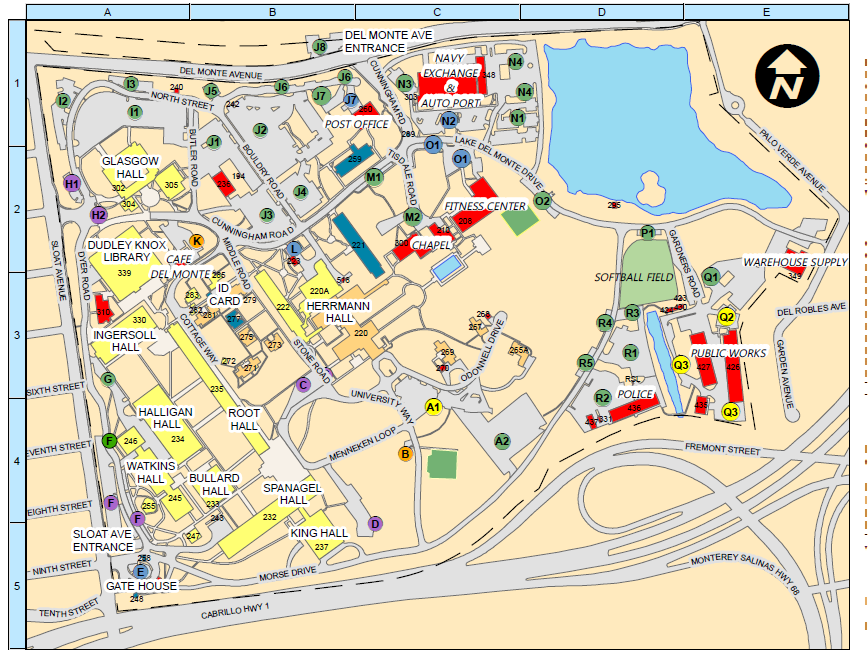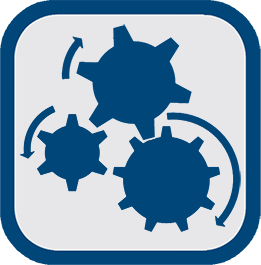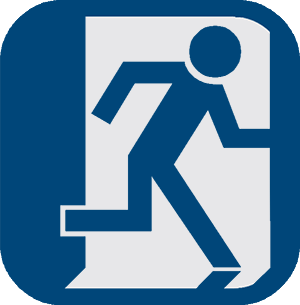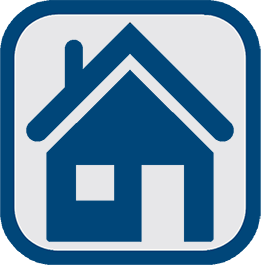Emergency Management - Safety
Note: This guidance was created for the Naval Postgraduate School population. If you are from another command, the information provided here may be useful for you, but it is also highly recommended that you check with your command for any special guidance or considerations.
Click here for the Emergency Action Plan
Click here for Winter Safety Guidance
Emergency Notifications
- Monterey County Alerts: https://local.nixle.com/county/ca/monterey/
- AlertMontereyCounty - Sign up, click here.
- Nixle - To receive emergency information, for daily fire updates for the River and Carmel fires text MCFIRES2020 to 888777.
- Call or text 211.
- Call, Operators can provide updated fire and evacuation information.
- Text “fire” or “wildfire” to 211-211, add your zip code and receive links to current information.
REPORTING/REQUESTING work for damaged areas at NPS-- Contact Public Works: https://nps.edu/group/public-works
-
Emergency Work Requests: Call (831) 656-2526 (manned 24/7/365)
-
Routine Work Requests: Please email NAVFAC-SW-Monterey-Service-Desk@us.navy.mil
EVACUEES:
-
Contact your supervisor and NPS Command Duty Officer (CDO@nps.edu) 831-901-6649 to inform them of your situation.
-
NPS Travel Office: https://nps.edu/web/travel/evacuations
-
If an authorized patron (AD, DOD, Retiree) has been forced to evacuate their residence because of the fires, reservations at the RV Park or NGIS for the duration of the evacuation order for their residence (patron expense), is allowed.
-
Call the NGIS front desk directly, 831-920-0974 ext4
-
Quick Contact List – NSAM Police Department Duty Phone Numbers: Watch Commander: 831-392-7228; Patrol Supervisor: 831-901-6115; SECO 831-200-5067.
Resources:
CAL FIRE:
- Active Incidents (Maps and Information)
- CAL FIRE Facebook
EPA:
MONTEREY:
- City of Monterey
- Monterey County Emergency Services
- Monterey Bay Air Resources District
- Wild Fire Smoke Resources
- Air Quality information
- Wind Map
NSAM:
Incidents/Thermal Hotspots/Smoke Forecast: https://disasterresponse.maps.arcgis.com/apps/webappviewer/index.html?id=2ff1677111ae4018ac705fcce7c3312f
U.S. Forest Service smoke map forecast: https://tools.airfire.org/websky/v2/run/standard/CANSAC-1.33km/2020081800#viewer
Current air quality and air quality forecast:
https://tools.airfire.org/monitoring/v4#!/?category=PM2.5_nowcast¢erlat=36.6314¢erlon=-120.5509&zoom=7
Monterey County Fire Agencies--radio feed: https://www.broadcastify.com/webPlayer/20102
SPCA Shelter for pets: https://www.spcamc.org/for-pet-owners/prepare-for-a-disaster/
Next big storm resources:
- Access up-to-date weather information at: weather.gov
- Prepare for disasters with this Disaster Ready Guide
- Sign up for emergency alerts as they become available for each county:
- Monterey County: Alert Monterey County
- San Luis Obispo County: Reverse 9-1-1
- Santa Cruz County: CodeRED
- Prepare for stormy weather in advance with PG&E's safety tips.
- Know before you go – Caltrans Road Conditions: QuickMap
Get the latest emergency information from your county websites here:
Health information:
Controls for particulate material in the air, are similar to what we are doing now for COVID. Stay inside, wear a mask if outside to control for gross contamination, monitor progress in the event you must evacuate your area. If personnel are susceptible (vulnerable population), It is highly recommended to shelter in place (stay indoors). Vulnerable populations are those who have diseases which can be aggravated by PM, see below for more information.
Health effects can be immediately felt by sensitive groups. Healthy individuals may have trouble breathing and throat irritation with prolonged exposure. Particulate material (PM) is high for PM 10 and 2.5. PM10 affects the upper respiratory tract (nose, throat, and bronchioles) while PM2.5 affects the lower respiratory tract (lungs).
PM10: Exposure can result in eye and throat irritation, coughing or difficulty breathing, and aggravated asthma.
PM2.5: The most severe impacts are on the lungs and heart. Exposure can result in coughing or difficulty breathing, aggravated asthma, and the development of chronic respiratory disease.
CONUS DoD Evacuations:
For questions contact Mr. Carr at NPS Travel, vacarr@nps.edu
Emergency Management
Emergencies happen, often with little or no notice. By taking action beforehand, you can be prepared for any emergency. Be Ready Navy—Be informed before, during, and after an incident; make a written family emergency plan; and build an emergency supply kit good for at least three days.
|
|
See the links below for information for the following scenarios:
- Essential-Items
- Build a Kit
- How to prepare, wildfire
- BE-READY-trifold
- emergency-plan
- Shutting off power for safety
- Evacuations from a Navy Installation
- Safe Havens for Navy Personnel
- Civilian Shelters for Navy Personnel
- Sheltering-in-Place at a Navy Installation
- OCONUS Emergency Actions
- Mass Warning and Notifications at Navy Installations
- Lockdown
|
|
Know Your Workplace Hazards
Employees need to be aware of where any hazardous materials are being stored in their work space and avoid these areas in the event of a natural disaster or fire. A full listing of the hazards for all NPS Spaces can be found on our "Know Your Workplace Hazards" page.
Evacuation
The purpose of evacuation is too safely and quickly lead occupants off the installation to a safe assembly point located a safe distance away from the installation. When necessary, NSAM Force Protection will control traffic and crowds during an evacuation. Buildings within NPS control will evacuate their buildings in accordance with their building evacuation plans. When NPS is order to evacuate all personnel will follow the instruction of the NSAM first responders. The following illustration is how NSAM is laid out in zones. It is anticipated that NSAM will evacuate the installation by zones.

Navy-Wide Personnel Accounting
If NSAM or any of Navy community is evacuated or in a declared disaster area, the Navy will use an order to account through the Navy Family Assessment and Accounting System (NFAAS). NFAAS allows commands to account for all Active Duty, Reservist, DOD/NAF employees and Navy families. NFAAS will also be used to assist personnel if they need help.
The Navy calls an area affected by a disaster a geographic area of interest (GAOI). After a disaster, all Navy personnel and their families residing, deployed to or working within a GAOI are required to check in at the first available opportunity. There are three options available to check in.
- Members and employees can check in directly with their commands and provide their family's status and whereabouts. This is the primary way to account. Commands will upload the information into NFAAS.
- If they are unable to reach their command, Sailors, family members and civilians can muster on NFAAS at https://navyfamily.navy.mil.
- If unsuccessful, the third option is to account by phone through the Navy Emergency Coordination Center at 1-877-414-5358 or 1-866-827-5672 (TDD 1-866-297-1971).
After mustering, it is equally important that member complete a needs assessment in NFAAS if they are impacted by the event.
If a member or Navy family needs help following a declared disaster, the Navy has resources that can support them during the emergency. NFAAS has a user-friendly assessment tool to coordinate and prioritize disaster-related needs. The system allows families to assess their needs in 19 categories including, medical, missing family locator, transportation, housing and personal property, financial, employment, child care, education, legal services, counseling and mortuary and funeral assistance.
Once disaster-related needs are identified, a case manager from a Fleet and Family Support Center is assigned. The case manager will contact the Navy family member to assist them with support that ranges from the urgent to the informational.
Access to the assessment information is restricted. Details of the assessment will not be provided to anyone outside the case management team without the provider's approval.
Before a Disaster
NFAAS
Providing contact information is critical in providing support to Department of the Navy personnel and their dependents during the recovery period following a disaster. NFAAS is the system utilized by the Navy to account for personnel and their families during widespread natural or man- made disasters. Accurate contact information of personnel and family members is required to facilitate a quick and accurate muster of personnel in affected areas.
All Personnel are required to log on to NFAAS and update their recall information quarterly.
AtHoc Alerts
AtHoc has replaced DesktopAlert (NPSAlerts) as NSA Monterey's mass notification system. AtHoc allows NSA Monterey’s Emergency Management Office to quickly and effectively communicate critical information to NSA Monterey personnel in emergency situations through numerous communications channels, including desktop popups, email alerts, mobile app alerts, phone calls, and SMS/text notifications.
Personnel are encouraged to update their AtHoc Self Service profile with their work location(s) and additional contact methods. For instructions or more information about NSA Monterey’s AtHoc, click here
|
|
Click the links below to open a form you can fill out to make a Family Emergency Plan and Contact Cards.
For more helpful information on Emergency Preparedness, see www.ready.navy.mil
NSAM Emergency Management Plan:
The governing base instruction for Emergency Management is NSAMINST 3400.1 (series). To view the latest copy of the instruction and the supporting documents, go to Gateway 2.0 and log in.
If you have a valid CAC, you are able to enter Gateway 2.0 as an anonymous user. Anonymous user allows an individual to browse public areas. All CNIC users will have Elevated Access in Gateway 2.0 as long as they have performed TWMS Self-Service. The Self-Registration process allows a non-CNIC CAC user to move from Anonymous to Elevated Access. Users can Register Here.
The below documents are FOUO and require an NPS User acount to View.
Support Annexes (SA): |
Functional Area Annexes (FAA): |
Hazard Specific Appendices: |
|
|
|
Basic Anatomy of an Emergency Kit:
|
Natural Disaster Kit If you have to evacuate, you'll have to be ready to grab some important papers such as: insurance inforamation, identification, money, and a list of names and phone numbers. If you put together an emergency kit, store it in something that is easy to find and carry, such as a large, zippered bag. Things to eat and drink if you lose power and the streets are closed Bottled water (having a supply of water-purifying tablets is also a good idea) Canned and dried food A can opener Vitamin pills Packaged crackers, cookies, and other snacks Powdered or canned milk
Other Important Items Raincoats, ponchos and umbrellas if you have to walk or work in the rain Blankets and sleeping bags if you lose heat or have to sleep somewhere else Heavy-duty work gloves Flashlights Portable radio (weather radios are ideal) Batteries Toilet paper Sunscreen |
|
Roadside Emergency Kit In case you are stranded, keep a kit of emergency supplies in your car. Basic Car Emergency Kit Road Flare with matches / warning triangle Auto distress flag Safety reflector vest Jumper cables Flashlight with extra batteries Fire extinguisher Extra fuses Nonflammable tire inflator Rags Auto manual Road maps Whistle Tools Screwdrivers (flat and Philips head) Pliers Vise grips Adjustable wrench Shovel Roll of duct tape Multi-tool pocketknife Tire pressure gauge Funnel Wire or rope Cold-Climate Necessities Ice scraper Emergency thermal blanket Traction aids (sand, rock salt or kitty litter) Jacket or raincoat, boots, wool socks Gloves Umbrella Extra Water Tire chains (for snow) |
|
First Aid Kit Keep a first aid kit in you rhome and in your car. Include any personal items such as medications and emergency phone numbers or other items your health-care privider may suggest. Check the kit regularly for items pas their expiration date and replace any used or out-of-date items.
First-Aid Kit for the Home or Car Compress Dressings Adhesive Bandages (assorted sizes) Adhesive cloth tape Antibiotic ointment Antiseptic wipes Emergency Space blanket Cold Compress Non-Latex Gloves (such as nitril) Aspirin Hydrocortisone Scissors Sterile Gauze Pads Tweezers First-aid Instruction Booklet |




